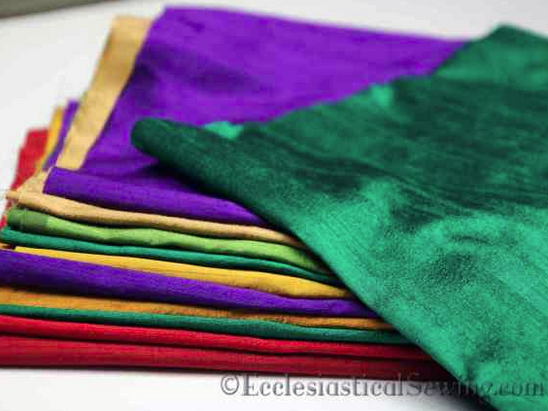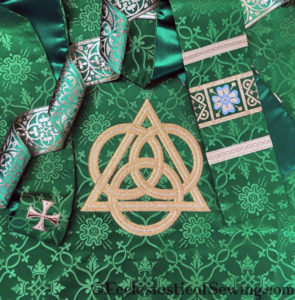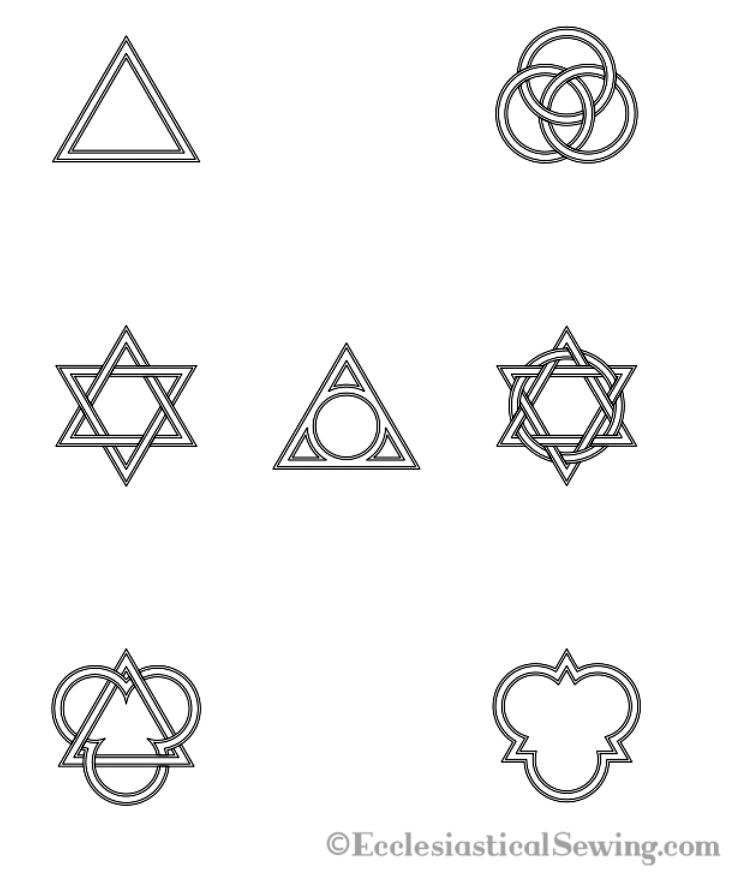Where to begin when sewing for your place of worship

In Biblical history, some early followers were mentioned as being specially gifted to sew priestly robes and intricate items to be used in worship. Just like the worshipers in churches throughout history, people in today’s churches also have the talent and the desire to create — from paraments for the sanctuary and vestments for the clergy, to altar linens, banners, and more.
When Carrie Roberts became involved in sewing for her church many years ago, she had a difficult time finding the specialty fabrics, trims, and other supplies she needed. In 2014 she started EcclesiasticalSewing.com to help others who shared her passion for creating vestments, paraments, and other fabric items for their own churches.
Roberts researched and compiled resources from around the world to create her online church sewing supply store, making it easy for others to find everything they need — from specialty fabrics and trims to patterns and more — all in one place.
While the means and methods of ecclesiastical sewing may have changed since Biblical times, the colors and the symbols remain the same — helping to prepare the heart of the worshiper for the themes and the messages of each unique liturgical season.
Where to begin?

Whether the message of the season is portrayed on a backdrop of white, ivory, red, green, violet, blue, or gold, the calendar of a church year is bountifully filled with seasonal events and holy days — each one recognizable with its own unique color and significant, embroidered symbols. These visual art forms can be created by those in the congregation who feel led to sew for their place of worship.
“If you feel led to sew vestments for your pastor or priest, I always recommend that people start by reviewing their church body’s liturgical calendar,” Roberts said.
A church’s website or publishing house usually has a color calendar that can be ordered and hung in the sacristy for easy reference.
Church year celebrated in colors
Whichever liturgy you follow, whether Catholic, Lutheran, Anglican, Episcopalian, or another, each denominational church body has its own liturgical calendar — depending on the rites each one follows — with the colors and times of celebration and festivals.
The colors are themselves significant and help to tell the story of each liturgical season. The church year begins with the blue or violet of Advent and preparation for the white of Christmas and the birth of Christ. Then comes the green after Epiphany, which lasts until Transfiguration Sunday, and the beginning of Lent. Lent is the violet season — a color signifying Christ’s Passion — in preparation for Easter. While Good Friday is somber in black for some churches, the white for Easter lasts 50 days until Pentecost, with one day in red, then back to white (depending on the church). Trinity Sunday is white and it is followed by a long green “ordinary” season.
Choosing what to make
As members of an altar guild or similar committee, those who sew must decide which liturgical season or color the church needs items for the most.
“The green season is one that is used the most often during the liturgical year,” said Roberts. “Green signifies hope, light, and growth. Perhaps you might choose to make something for the green season.”
The next question is deciding what specific item to begin with. Does the pastor’s stole need refreshing? Is a new banner or altar cloth needed? While choosing what to make, keep your own skills in mind, as well as your sewing equipment.
“Choices about the item and the symbol should be considered realistically in light of your sewing ability and your machine’s capabilities to create what you envision,” said Roberts. “Since most pastors wear stoles, making a stole is an easy place to start.”
A stole is a simple strip of fabric that is worn over the shoulders and hangs down to the knee or below. It can be identical on both sides or it can have complementary designs on each side. When designing a custom stole, choosing the style or pattern comes next. It helps to know if the need is for a pastoral stole (worn by an ordained clergy member) or a diaconal stole.
Symbols

After choosing to make a green stole and selecting the fabric, next choose the style of embellishment or embroidery design. Do you want to order a digital symbol and embroider it yourself? If you don’t have a machine that does embroidery, you will need to find someone who can do it for you. Another option is ordering a preembroidered stole that can then be sewn together.
Since green refers to ordinary times and Trinity times, Trinity symbols are often chosen for the embroidery design. These exemplify the three persons of the godhead, often shown as a triangle with a circle inside, or an interwoven triangle with three circles.
Other designs appropriate for the green season correspond with readings of the season describing the church as a “ship sailing the seas”—symbols with a ship are common in green/Trinity season. Another symbol is the church built on the rock, based on Peter’s confession, and Jesus who said of him, “On this rock I’ll build my church.” Other common symbols for the green season are a fish, two fish and five loaves, a boat with a net signifying fishers of men, or a good shepherd.
Sew it up!
Before committing yourself to ordering anything, it is of the utmost importance to ask your priest or pastor about your chosen colors, symbols, and trims. They will tell you if something is appropriate and fitting to be used in your church setting. Once your clergy has given approval, you are free to begin!
After choosing to embroider the symbol and selecting a digital file from an online liturgical fabric supply website, the file will be provided for you to use in an embroidery machine. Always do a test or two with colors and threads prior to embroidering directly onto the actual fabric. Proceed to making the final project when you feel confident that your test runs were successful.
“For each stole you sew, see what works and what doesn’t and then do another one right away,” said Roberts. “By the time you get to the second or third stole, you will be doing really well and have more confidence.”
Caring for paraments and vestments
Roberts recommends dry cleaning when needed, but with proper hanging and storage, she says vestment items can go years without needing cleaning. The best thing is prevention and proper care, such as taking vestments off right away after church—don’t wear them to the church coffee hour or potluck! Don’t crease or fold them, but hang them long, such as on a stole hanger. Sometimes an older church will have a large drawer in the sacristy to spread them out flat.
“Fear is often the thing that holds us back from attempting to create vestments or paraments,” said Roberts. “We have to jump in and do it. Once we get over the fear, then we discover that the self confidence will be there for the task.”
Ultimately, those who sew for the church discover that it is more than just sewing a stole to help to tell the story of a liturgical season. They can almost sense the camaraderie and fellowship of church history as they follow the footsteps of the church fabric artisans who have gone before them—sewing as their act of worship. >
NOTE: Click here to order iron-on transfer patterns for a variety of crosses and other liturgical symbols from the NAGA Sacristy Shop. For additional pattern sources, visit ecclesiasticalsewing.com.
Carrie Roberts, EcclesiasticalSewing.com
